79% of marketing leads do not convert into sales. Why? Because marketing and sales teams spend more time on leads who are not truly interested. If this is you, it’s best to use predictive lead scoring.
To help you out, we will explain how predictive lead scoring works, why you need it for 2025 and beyond, and how you can start using it to build your lead generation funnel. By the end, you will see how it is possible to increase your ROI by 2.9x. Let’s get down to it.
What Is Predictive Lead Scoring In Sales & Marketing?
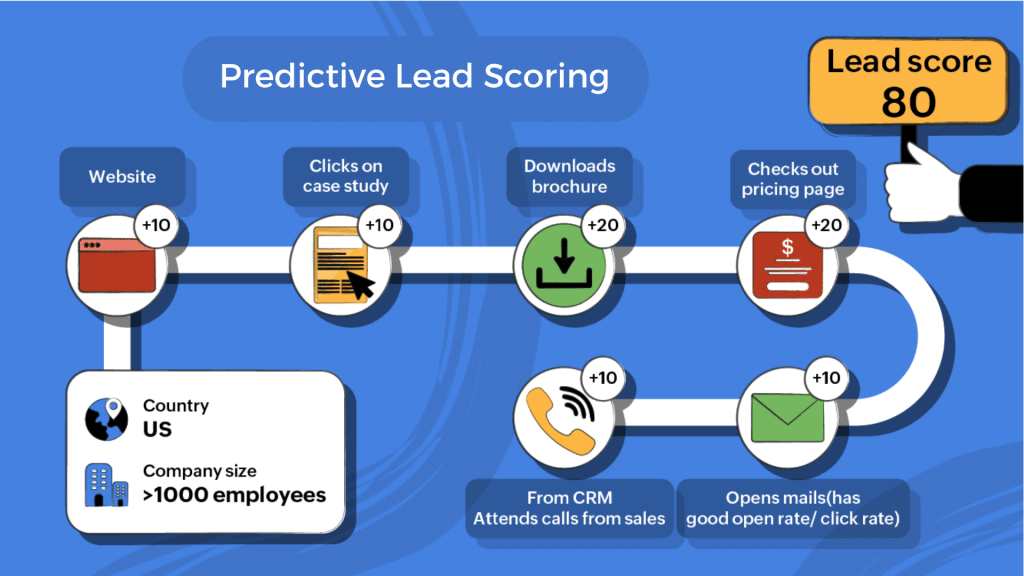
Predictive lead scoring is the process of determining a lead’s potential or a customer to purchase your business. It is based on the previous customer’s behavior and uses artificial intelligence and predictive machine learning models to analyze the data.
Here’s what predictive lead scoring looks at:
- Churn risk
- Engagement levels
- Customer lifetime value (CLV)
- Preferred products or services
If you input wrong data, predictive scoring is as good as guessing. So, make sure that the data you input is relevant, accurate, and up to date to get the right output.
Traditional vs Predictive Lead Scoring
Assess your existing lead scoring process to determine if it is worth changing to a different lead scoring approach.
Aspect | Traditional Lead Scoring | Predictive Lead Scoring |
|---|---|---|
Basis for Scoring | Age, location, and job title | Uses AI and machine learning to analyze past data |
Data Sources | Basic information and manual inputs | Online behavior and outside data |
Accuracy | It can have bias and is prone to human error | Highly accurate because it learns from real data |
Insights Provided | Who clicked on an email | Who’s most likely to buy |
Who Should Use It | Small businesses or teams with simple needs | Large businesses with lots of data and prospects |
If you are trying to understand traditional lead scoring vs predictive scoring approach on a deeper level, consider your business’s size and needs. Traditional lead scoring models work well for small businesses that do not have complex data to manage.
But if your business is growing and you have many potential customers, understand predictive lead scoring–how it works and how to do it. With smart tools, it can analyze past customer behavior and give you the best results on which leads are most likely to buy from you.
3 Benefits Of Predictive Lead Scoring
Identify where predictive scoring can make a difference to your sales strategy below.
- Identify Sales-Ready Leads: Find the leads who are prepared to make a purchase.
- Speed Up Sales Cycles: Reduce the time engaging with poor-quality leads.
- Yield Higher Conversion Rates: Make your outreach more relevant.
How To Implement Predictive Lead Scoring In 5 Steps
Review all steps to understand the full implementation process, then tackle each 1 to set up your scoring system.
Step 1: Understand Your Ideal Customer Profile (ICP)
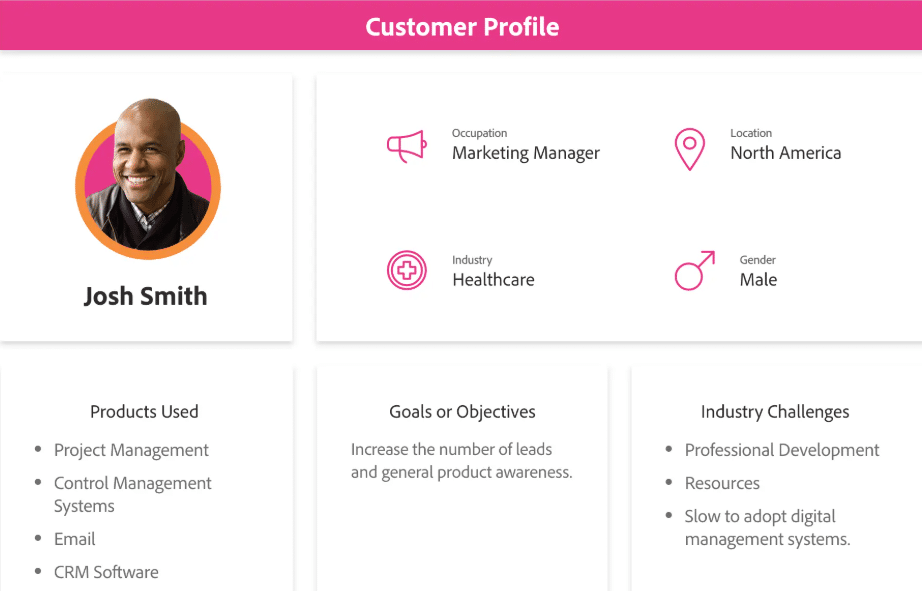
The ICP describes the type of customer who is most likely to benefit from your product or service. It outlines the characteristics and attributes of your ideal customers so you can focus your marketing and sales efforts on leads who can be your loyal customers.
Leads that match your ICP are more likely to be high-value customers. Define your ICP by taking these steps:
- Assess the customer that you like to get the highest ROI.
- Understand what your product solves customer needs.
- Figure out the industries or job positions the leads represent.
Here is an example of how you can do it:
- Industry: B2B space
- Company Size: 50 to 200 employees
- Job Titles: Specific to Marketing Directors & Sales Managers
- Pain Points: Customer retention and ways to get leads
- Behavior: More engage with email marketing campaigns, attends product webinars, and purchases after a demo call
Once you figure it out, use this information to build your lead scoring system. The goal is to identify them first so you can generate B2B leads who most closely match your ICP.
Prioritize leads who show higher engagement. Consider those who download resources, attend webinars, or interact with your content multiple times. This will help you focus on the most interested prospects.
If you find it difficult to gather and analyze this data on your own, hire marketing assistants to make the process easier. They can help you make sure your lead generation and customer analysis only target high-value leads and that the process is done right. Meanwhile, you get more time to do other critical tasks to grow your brand.
Step 2: Choose The Right Predictive Lead Scoring Models
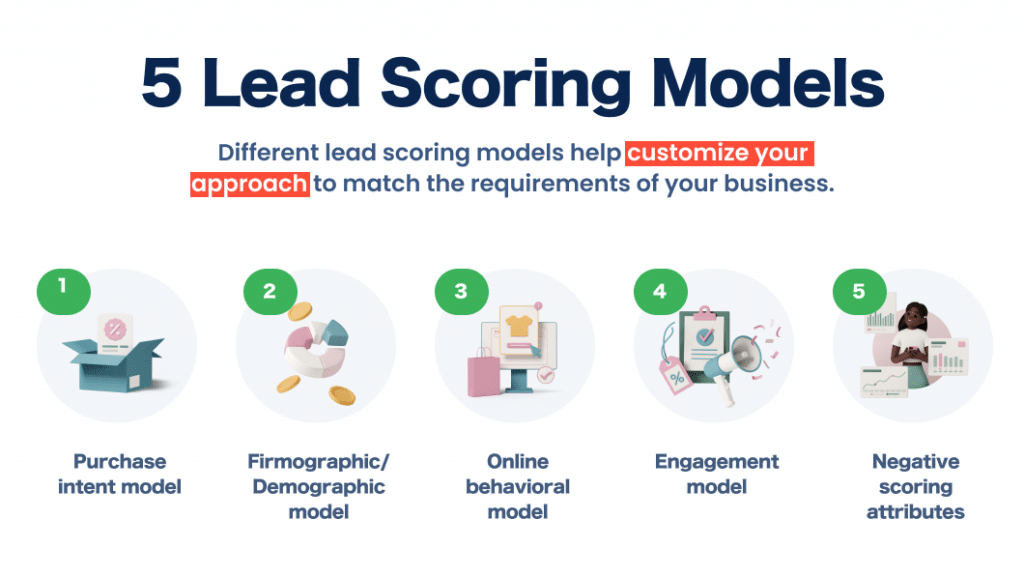
Different models capture lead behavior, intent, and fit. To really understand your leads—what they do, what they want, and whether they’re the right fit. Choose a lead scoring model that gives data for e-commerce analytics.
This lets you see how your sales and marketing are doing, measure the traffic on websites, and know how customers interact with your business.
Here are the lead scoring models and metrics to track:
- Engagement: Email opens and post clicks
- Firmographic: Company size, industry, & location
- Purchase Intent: Strong buying signals like product demos
- Online Behavioral: Page views, downloads, and time spent on the site
For negative scoring attributes, you can do it by deducting points when leads unsubscribe. But if you have limited website visits or get incorrect contact details, you can also use it.
To make the most of it, consider incorporating a model like a lead scoring widget to close the lead conversion gap and assign points correctly. Look at the leads’ demographic and behavioral profiles and make sure you engage them at the proper stage in their buying journey.
Step 3: Build Your Lead Scoring Criteria & Thresholds
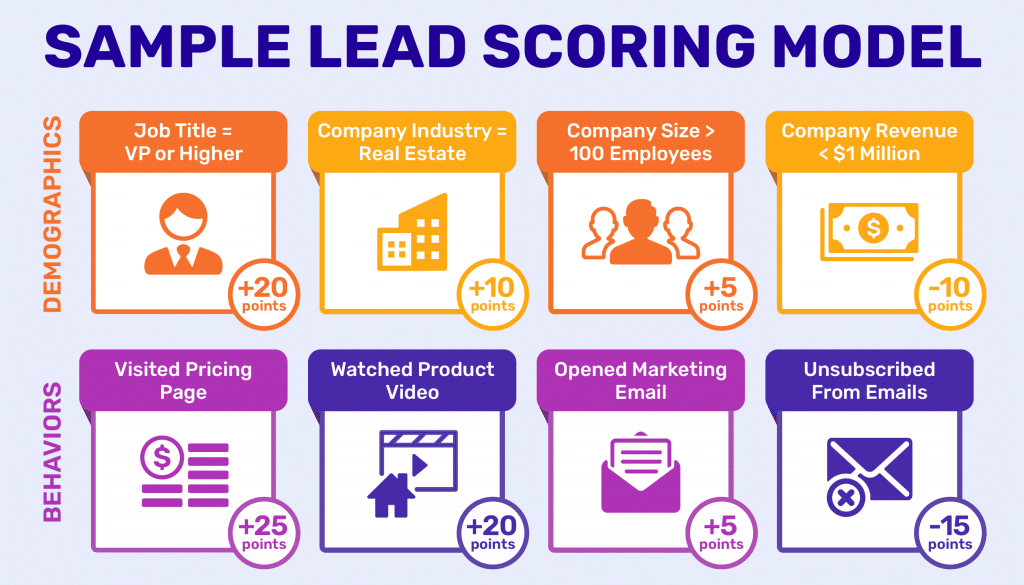
Lead scoring assigns numerical values to prospects based on how they align with ICP and their engagement with your brand. The ‘predetermined criteria’ you set will be key to focusing your efforts on high-potential prospects until they are ready to engage.
As you do this, consider key metrics like:
- Engagement signals
- Behavioral indicators
- Firmographic attributes
To start, pay attention when a lead interacts with your social media posts, asks for a demo, or reaches out for more information. These actions show that they are interested and want to learn more about what you offer.
Also, look at how leads behave on your website. For example, if they visit multiple product pages, open your emails, or download your content, it shows they are learning more and getting closer to making a decision.
Check the details about the lead’s company, too. Are they in the right industry? Do they have the right company size, or are they located in a region where your product is in demand? These factors help you see if they are a good fit for what you sell.
3.1 Strategies To Score Leads
The strategy you choose should align with your business goals, ideal customer profile (ICP), and buyer’s journey. Consider a mix of explicit criteria (attributes provided by the lead) and implicit criteria (behavioral signals).
Here are the explicit criteria to look at:
- Job title
- Industry
- Company size
- Geographic location
Then, for implicit criteria, consider:
- Website visits
- Email interactions
- Free trial sign-ups
- Content downloads
- Request a full demo
Take this example to map your lead attributes and assign scores:
Criteria | Weight | Explanation |
|---|---|---|
Job Title (Decision-Maker) | 10 | Decision-makers likely drive purchases |
Company size (500+ employees) | 8 | Larger companies have bigger budgets |
Industry (like Marketing) | 7 | Target industries that fit your product offerings |
Website visit (5+ pages) | 5 | It signals strong interest in your solutions |
Downloaded whitepaper | 6 | Suggests leads want to search for solutions |
Attended webinar | 8 | Shows direct engagement with your brand |
Previous purchase history | 9 | Hints future purchases and inquiries |
Engaged on social media | 4 | Suggests interest in your social media posts |
Free trial sign-up | 10 | Shows a strong signal of purchase intent |
What’s next?
Set thresholds to categorize your leads. For example, classify two leads (lead A) with a score of 80+ as “hot leads” and mark the other (lead B’s score) below 30 as “cold.” If it falls into the latter, conduct email campaigns or content marketing to increase your engagement.
3.2 Set Up Score Points System
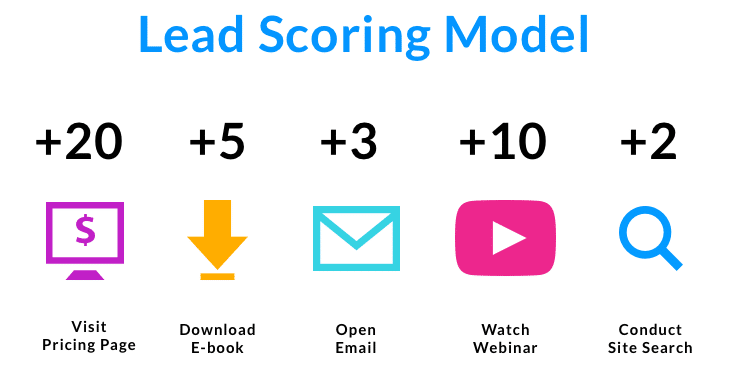
A scoring point system helps define thresholds for your Marketing Qualified Leads (MQLs) and Sales Qualified Leads (SQLs). It prioritizes leads in terms of engagement and readiness to buy. As you do this, give action points to how the lead scoring model calculates the points you set.
Do it like this way:
Score Range | Category | Action |
|---|---|---|
0-20 | Cold lead | Add to email nurturing campaigns. |
21-40 | Cold to warm lead | Add to email nurturing campaigns and send emails. |
41-60 | Warm lead | Send personalized marketing emails. |
61-80 | Marketing qualified lead | Send targeted content and offers. |
81+ | Sales qualified lead | Assign to the sales team for follow-up. |
Be sure to review your lead score thresholds to show changes in buyers’ behavior. This will help your sales team to keep up with the most promising leads. More often, this assures you give high-intent leads with timely follow-ups, which helps you close even more deals.
Step 4: Integrate The Model Into Your CRM Or Lead Scoring Software
Your CRM should pull in data from all lead sources, like forms, social media, or emails, in an instant so your scoring model gets as much accurate information as it can.
To do this, answer these questions:
- How often do the lead score updates?
- How quickly does your sales team follow up with top leads?
- How many of the high-scoring new leads turn into actual sales?
- How well does the system flag high-potential leads for quick sales follow-up?
Check out popular lead generation software like Optinmonster, Uplead, and Leadfeeder to know about your lead behavior and engagement. Connect the tool with your preferred CRM, like Salesforce or your existing ones, to funnel lead data into the system.
After that, run tests to confirm that lead scores are updated correctly in real time and that the CRM triggers timely follow-ups and personalized outreach. You can also take advantage of the benefits of AI phone answering systems to optimize your sales process.
These systems answer basic questions, understand customers’ needs, and redirect promising leads to your salespeople. Plus, they log caller information in the CRM and set reminders for follow-ups to keep your sales pipeline active.
Step 5: Configure & Test Your Scoring To Get More Accurate Results
Test your scoring to catch problems, if there are any. This is to avoid wasting time on low-quality leads, as well as your time, effort, and resources.
Here are the variables you should test:
- Time a lead responds
- How your scoring system performs
- Score decay (leads that disengage)
- False positive or negative system rates
Review historical information to determine whether the model uses the lead prioritization algorithms. Assign higher scores to leads who express interest in buying and lower scores to leads who are expected to but do not convert during the time you allocate.
Check that the actual results correspond with the scores assigned. If valuable leads are not scoring as high as they should, adjust your marketing automation KPIs so that the focus is on actual engagement instead of initial impressions. Use this score decay system to decrease points for leads that disengage, then test it more often.
4 Real-Life Application & Use Cases Of Lead Scoring
Look for similarities between your business and these use cases to find lead-scoring strategies you can work with.
A. B2B Sales Optimization – Jobma
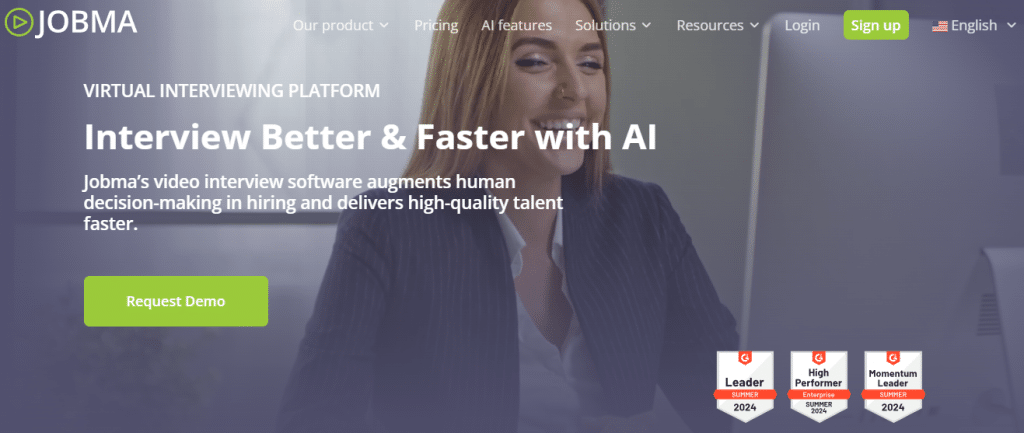
Predictive lead scoring is particularly important in B2B because it enables both the sales and marketing teams to shift their focus to leads with a higher chance of becoming clients worth more than average.
Prospects are scored depending on top influencing factors like company size and how well the lead aligns with your product or service.
Take Jobma, a video interviewing software provider, as an example. They use lead scoring for recruitment to nurture top leads and avoid wasting effort. Higher scores are given to leads who sign up for free trials, attend webinars, or download whitepapers.
They score leads on recruitment so that they carry out the lead engagement and prevent wasting resources. Those who register for a free trial, view a webinar, or download a white paper receive greater grades.
However, those who book demo requests or learn about other prices are scored higher. It is important to note that those who simply browse through the blog or download general reports get a lower score.
What can you extract from all of these?
- Follow up to ensure the right leads get attention first.
- Focus on leads that engage the most (ex. trial sign-ups).
- Look out for leads who show buying signals (about pricing).
B. E-Commerce Personalization – Armra

If you are in the e-commerce niche, lead scoring categorizes marketing campaigns to viable and potential customers for better effectiveness. It evaluates processes like purchase activities, browsing history, and attention shown toward some products.
As a company specializing in colostrum supplements, Armra relies on lead scoring to avoid the unnecessary costs of selling. Those who go to particular product pages, sign up for the newsletter, or put items of interest in a shopping trolley are the ones that they track.
When people leave the carts, email them with discount offers. Give users who purchase in larger quantities or sign up for auto-shipment plans with VIP loyalty perks.
Here, you learn how to:
- Make special deals for high-scoring customers and loyalty deals, too.
- Provide incentives to attract back those who have abandoned purchasing the product.
- Target those who are interested in the product and are already engaged (adding products to the cart, subscribing).
C. Healthcare & Safety Lead Management – GetSafe
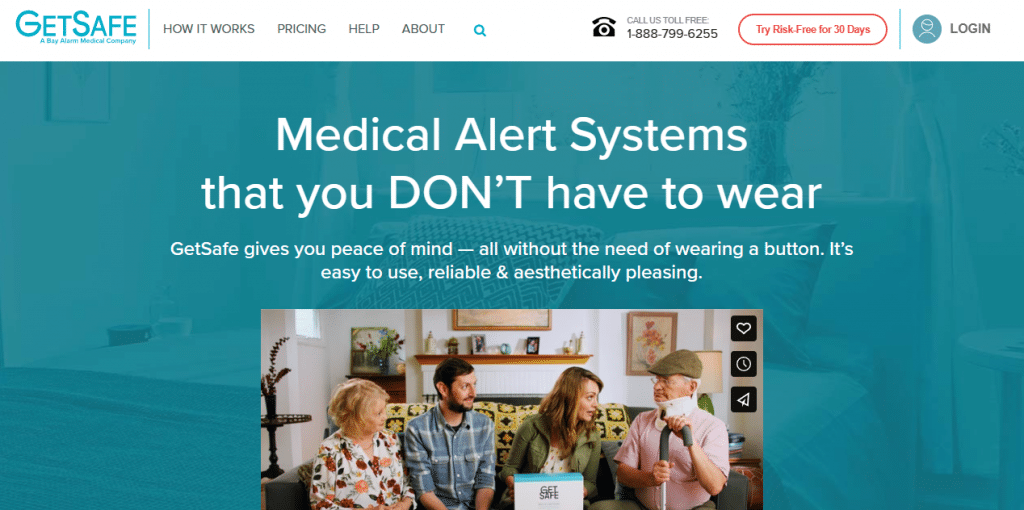
With the help of lead scoring, it becomes easier for healthcare companies to recognize and prioritize high-value leads, which helps in their follow-up and qualification process. To be proactive, classify leads based on compliance, safety, and cost constraints.
GetSafe is a medical alert systems provider that responds to product-related queries through lead scoring. Those who request appointments, resource downloads, and even peruse the pages related to specific items are considered strong leads. Casual visitors or readers of generic articles score lower.
Here are what you can learn:
- Respond quickly to consultation requests to address urgent needs.
- Fast-track top-scoring leads to sales agents for faster, more targeted follow-ups.
- Focus on engaged users interacting with product pages for personalized outreach.
D. Legal Service Optimization – Christensen Law
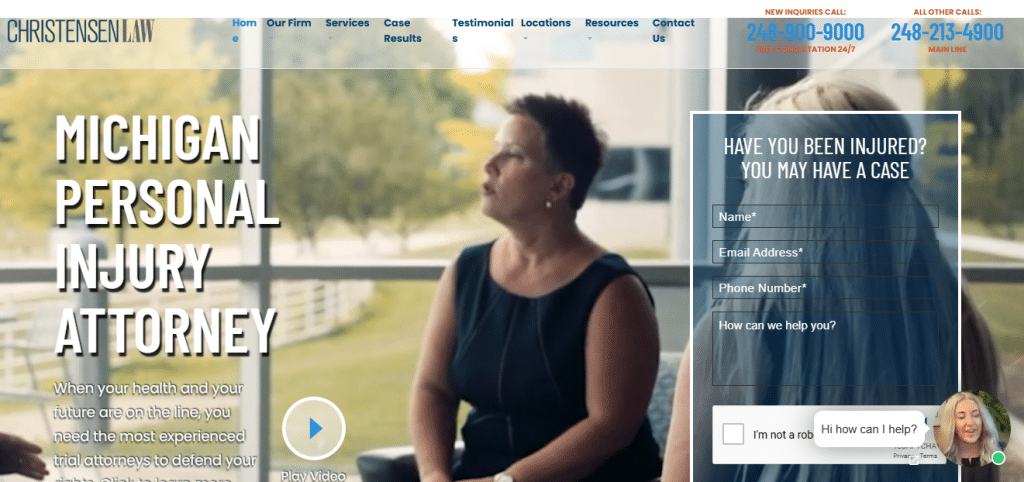
Advocate care agencies resort to lead scoring to classify each prospective client desirous of legal services. They assess the details of the case, its importance, and how many legal maneuvers the client had in the past to know the people who require assistance the most.
If you have a personal injury firm like Christensen Law, carry out lead scoring for inquiries submitted via the personal website. Emphasize the leads who send case assessment forms or who make phone calls.
Then, clients who download legal guides on requesting to make an accident claim or who read the answers to questions related to personal injury’s particulars get a middle score. But give lower scores to general website visitors without further engagement.
With this, you have the chance to:
- Quickly engage leads who initiate case evaluations or calls.
- Nurture potential clients with helpful content like guides and FAQs.
- Prioritize leads showing strong intent by completing forms or making direct contact.
Conclusion
Now, define what you want to achieve with predictive lead scoring. Is it to boost your sales outreach strategy, improve email follow-ups, or achieve higher lead qualification rates? Focus on 2-3 key goals and refine your process until you see results.
Need help getting started? Hyperise offers hyper-personalized outreach tools with 100s templates and stock images to help you attract more high-quality leads. Start your 14-day free trial today to get access to those templates and our marketing toolkits.
Author Bio:
Burkhard Berger is the founder of Novum™. He helps innovative B2B companies implement modern SEO strategies to scale their organic traffic to 1,000,000+ visitors per month. Curious about what Novum your true traffic potential is?
Last Updated on December 27, 2024 by Ian Naylor